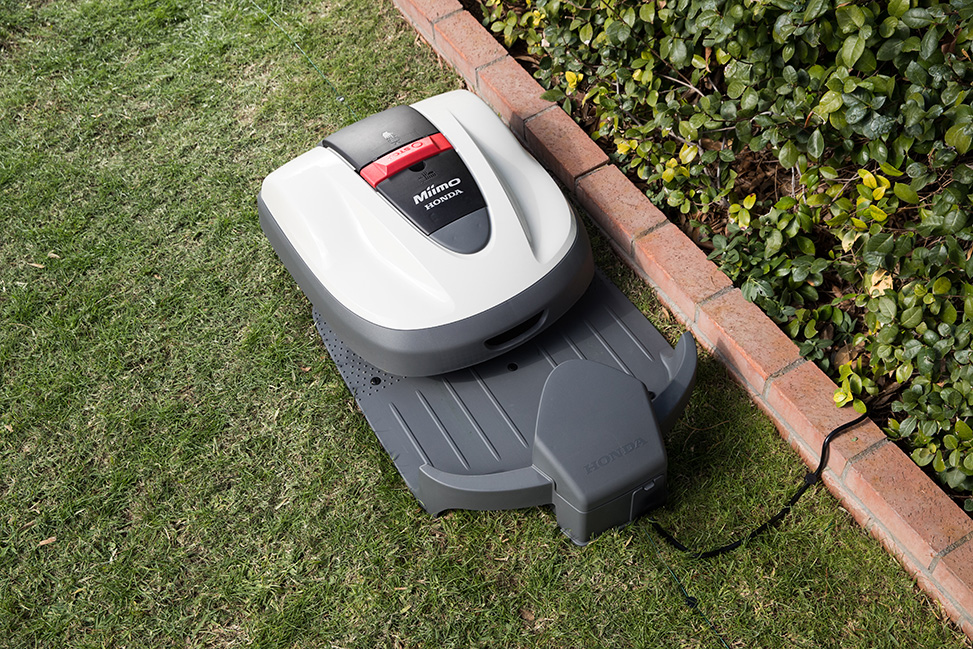by Matt Lollar | Jun 28, 2018
A new research project at the West Florida Research and Education Center in Jay, FL is looking into the quality of turfgrass cut with a robotic mower. The study is to determine whether the quality of St. Augustinegrass can be improved by continuous mowing with a robotic mower at 2.4″ height instead of the traditional mowing height of 3.5″, removing only a third of leaf blade material per mowing.
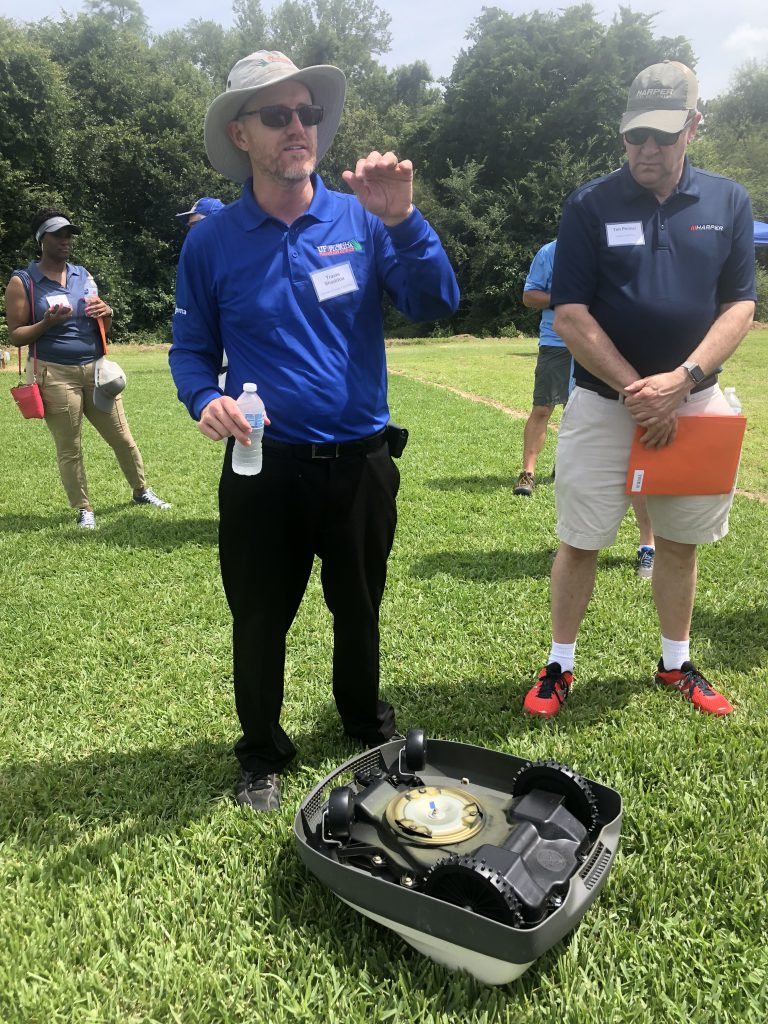
Dr. Shaddox talking to participants at the 2018 Gulfcoast Expo & Turfgrass Field Day. Photo Credit: Matt Lollar, University of Florida/IFAS Extension.
The mower being tested is the Miimo manufactured by Honda. This particular model mows and charges on its own and can mow up to 0.37 acres on one charge. It can mow in three programmable cutting patterns: directional; random; or mixed. The study is utilizing the random cutting pattern.
The mower’s three, two-sided blades are mounted on a circular head that can rotate both clockwise and counter-clockwise. The head automatically switches between clockwise and counter-clockwise rotation to reduce wear on the blades. The blades are basically just two-sided razor blades. A buried guide wire is installed on the perimeter of the lawn to serve as a boundary.
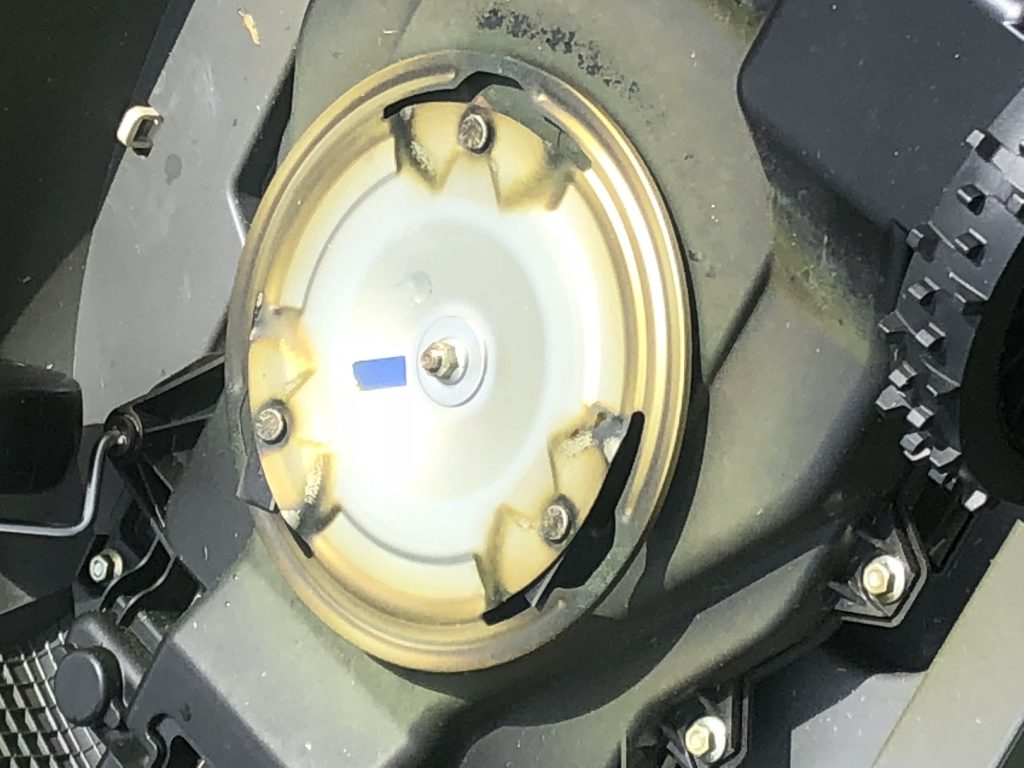
A close-up shot of the Miimo mower blades. Photo Credit: Matt Lollar, University of Florida/IFAS Extension.
So far, the plots cared for by the robotic mower look promising! The blades on the robot are much finer than those found on a common rotary mower. Because of this, they cut more cleanly and tend to tear the grass blades less often than the rotary mower. Other robotic mowers on the market include the Worx Landroid, Husqvarna Automower, and Bosch Indego. Please stay tuned for future robotic mower evaluations on other products, energy consumption, and nutrient evaluation.
by Ray Bodrey | May 4, 2018
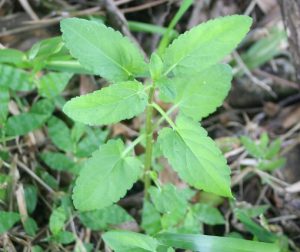
Figure 1: Florida Betony, Stachys floridana. Credit: UF/IFAS Range Cattle Research & Education Center.
If you look closely at your yard, there is a good chance that you will find a plant that, depending on who you ask, is considered either a native wildflower or a weed and there are more than a few species that fit this description. If, upon even closer inspection, you find a plant with root tubers that resemble egg casings or even a rattlesnake’s rattle, you’ve stumbled upon Florida Betony.
Stachys floridana is a perennial broadleaf commonly referred to as rattlesnake weed due to it’s fleshy, white, segmented underground tubers. The plant has an erect stem with leaves that are opposite, shovel-shaped and coarsely serrated. The plant structure is very similar to mint. Flowers, emerging in late spring, are pinkish-purple in color. These inflorescences will also produce fruit, consisting of four nutlets. However, reproduction of the plant and it’s propensity to spread through lawns and gardens primarily occurs through dense root tuber development. Florida Betony’s growing range was originally confined to the state of Florida, but the commercial nursery trade played a major hand in dispersing the plant across the Southeast in the mid-1900’s. It can now be found as far west as Texas and as far north as North Carolina.
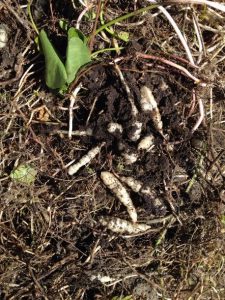
Figure 2: Tubers of the Florida Betony. Credit: Jill Bebee, UF/IFAS Gulf County Master Gardener.It can now be found as far west as Texas and as far north as North Carolina.
This time of year is when Florida Betony thrives. The moderate temperatures of fall and spring are the prime growing periods for Betony. In the heat of the summer, the above-ground structure of the plant will struggle and often disappear completely, only to reemerge in the fall. As a lawn weed, managing tuber development is key to controlling this plant. Applying herbicide to the leaves and stalk may seem at first to have conquered the weed. However, in most cases the tuber will simply regenerate. Glyphosate (Roundup) can be used effectively for control in ornamental plant beds where no turf is present. Be careful when spraying herbicides around trees, shrubs and other desirable plants as any foliar contact will cause phytotoxicity. If you have an infestation of Florida Betony in your turfed areas, there are a few options for control. Regular applications of three way broadleaf herbicides, such as mixtures of 2-4D, Dicamba and Mecoprop, are effective at suppressing this pesky plant. For more information and options, please contact your local county extension office or see the supporting information links below. Always refer to the product label for specific uses, precautions and application rates when using any herbicide.
Supporting information for this article can be found in the following the UF/IFAS EDIS publication, “Florida Betony Biology and Management in Turf” by J. Bryan Unruh, Ramon G. Leon, and Darcy E. P. Telenko: http://edis.ifas.ufl.edu/pdffiles/EP/EP38800.pdf
by Mark Tancig | Aug 1, 2017
Florida’s panhandle has received quite a bit of rain this summer. In the last three months, depending on the location, approximately 15 to 35 inches of rain have come down, with the western panhandle on the higher end of that range. In addition to the rain, we all know how hot it has been with heat index values in the triple digits. And who can forget the humidity?! Well, these weather conditions are just the right environmental factors for many types of fungi, some harmful to landscape plants, most not.
In the classification of living things, fungi are divided into their own Kingdom, separate from plants, animals, and bacteria. They are actually more closely related to animals than plants. They play an important role on the Earth by recycling nutrients through the breakdown of dead or dying organisms. Many are consumed as food by humans, others provide medicines, such as penicillin, while some (yeasts) provide what’s needed for bread and beer. However, there are fungi that also give gardeners and homeowners headaches. Plant diseases caused by various fungi go by the names rusts, smuts, or a variety of leaf, root, and stem rots. Fungal pathogens gardeners may be experiencing during this weather include:
- Gray leaf spot – This fungus can often show up in St. Augustine grass lawns. Signs of this fungus include gray spots on the leaf (very descriptive name!). This disease can cause thin areas of lawn and slow growth of the grass.
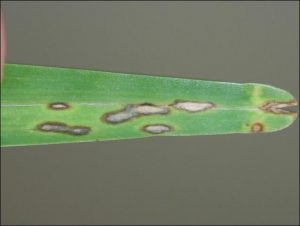
Gray leaf spot on St. Augustine grass. Credit: Phil Harmon/UF/IFAS.
- Take-all root rot – This fungus can attack all our warm-season turfgrasses, and may start as yellow leaf blades and develop into small to large areas of thin grass or bare patches. The roots and stolons of affected grasses will be short and black.
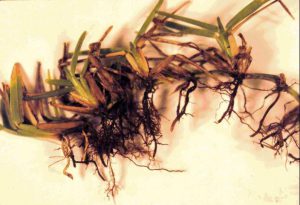
Signs of take all root rot. Credit: UF/IFAS.
Powdery mildew – This fungus can be found on many plants, from roses to cucumbers. It looks like white powder on the leaves and can lead to plant decline.
- Armillaria root rot – This fungus can infect a variety of landscape plants, including oaks, hickories, viburnums, and azaleas. Symptoms can include yellowing of leaves and branch dieback, usually in adjacent plants. Old hardwood stumps can harbor this fungus and lead to the infection of nearby ornamentals.
Because fungi are naturally abundant in the environment, the use of fungicides can temporarily suppress, but not eliminate, most fungal diseases. Therefore, fungicides are best used during favorable conditions for the particular pathogen, as a preventative tool.
Proper management practices – mowing height, fertilization, irrigation, etc. – that reduce plant stress go a long way in preventing fungal diseases. Remember that even the use of broadleaf specific herbicides can stress a lawn and exacerbate disease problems if done incorrectly. Since rain has been abundant, irrigation schedules should be adjusted to reduce leaf and soil moisture. Minimizing injury to the leaves, stems, and roots prevents stress and potential entry points for fungi on the move.
If you think your landscape plants are suffering from a fungal disease, contact your local Extension Office and/or visit the University of Florida’s EDIS website at http://edis.ifas.ufl.edu for more information.
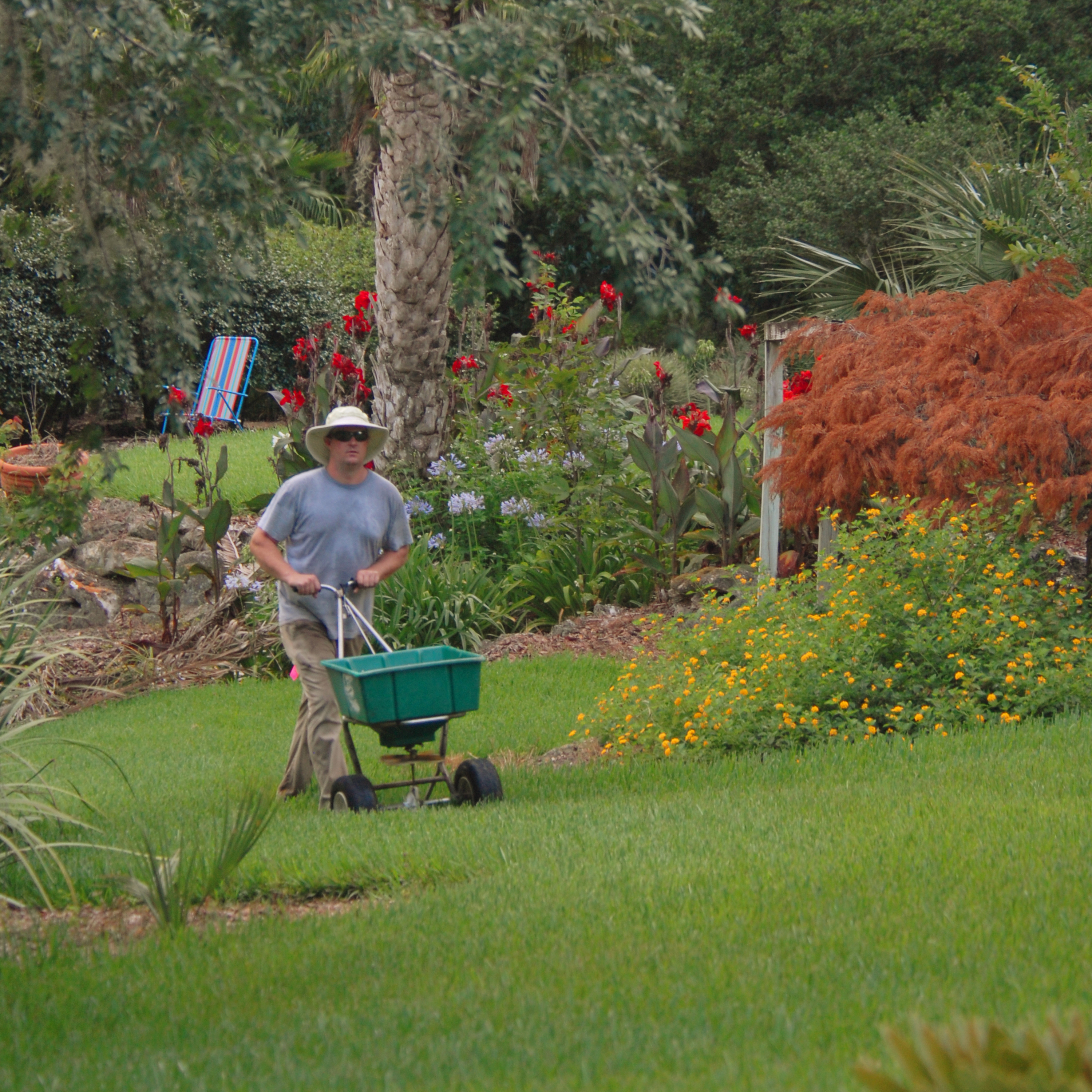
by Sheila Dunning | Jul 21, 2017
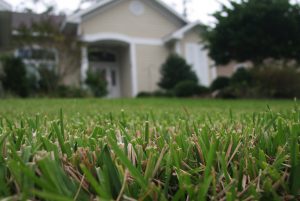
(UF/IFAS photo Thomas Wright)
Northwest Florida’s weather patterns can present challenges to maintaining a health lawn. Heavy rains promote fast growth and relentless sunshine causes lawns to fade. In the last 200 days we have received at least 68 days of rain. While the rest of Florida was experiencing record drought, the Panhandle was experiencing torrential downpours. With every drop of rain your spring fertilizer is being metabolized by the lawn, reducing how many nutrients remain in the soil. Even the best slow-release fertilizer will only last 3-4 months. The message is: “It’s time for more fertilizer.”
A healthy lawn is an important component of the urban landscape. Not only do lawns increase the value of a property, they also reduce soil erosion, filter stormwater runoff, cool the air, and reduce glare and noise. A healthy lawn effectively filters and traps sediment and pollutants that could otherwise contaminate surface waters and groundwater. Lawns require nutrients throughout the growing season to stay healthy. In Northwest Florida the growing season is typically April to October.
Proper fertilization consists of selecting the right type of fertilizer and applying it at the right time and in the right amount for maximum plant uptake. The type of fertilizer should be based on a soil test, available through UF/IFAS Extension. The timing of application and amount of fertilizer is dependent on the research-based recommendations for the grass species and the fertilizer analysis of the product being used.
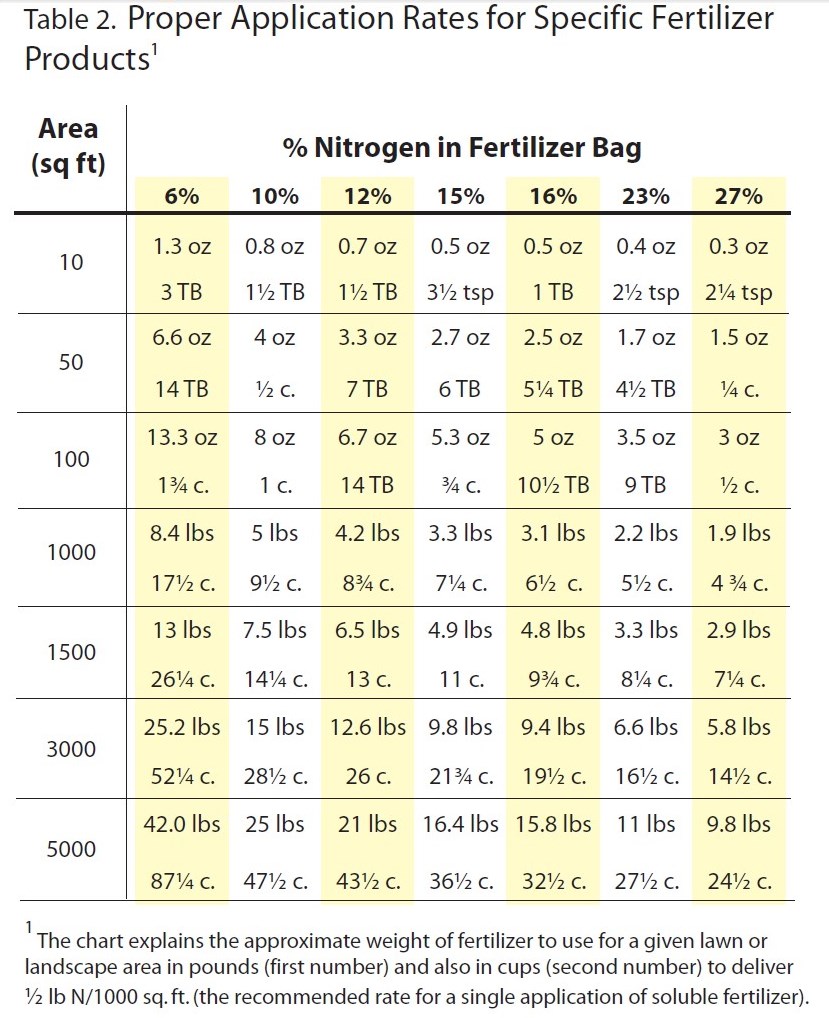
Chart excerpted from Florida Friendly Landscaping publication
Select only a fertilizer that states that the product is for use on residential turf. Do not use a fertilizer meant for flower or vegetable gardens on lawns. By Florida Administrative Code, Rule 5E-1.003, the Urban Turf Rule requires that the fertilizers being applied to residential lawns are labeled for the site and the application rates be followed. Typically, these products will contain both slow-release nitrogen and low or no phosphorus. Slow-release nitrogen will provide a longer-lasting response from the grass and reduces the potential for burning. For more information on the Urban Turf Rule go to: http://www.edis.ifas.ufl.edu/pdffiles/EP/EP35300.pdf.
With frequent rain the soil is also losing iron. Keep in mind that the green fading to yellow appearance in your lawn may be an iron deficiency. Before applying your summer fertilizer put out a liquid chelated iron. It will improve the health of the lawn while you are trying to find a dry day to fertilize. While it is necessary to water in fertilizer with ¼” of water to reduce burn potential and volatilization, never apply fertilizer when heavy rain is expected. The rainfall over ¼” can encourage runoff and/or leaching of that fertilizer, which can be costly and environmentally harmful.

by Ray Bodrey | Jun 29, 2017
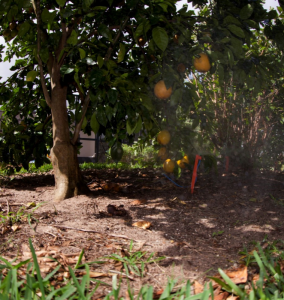 Although we’ve received much-needed rainfall of late, it’s still a struggle to manage moisture levels in our Panhandle landscapes this summer. During wet summer seasons, one recurring issue is that watering plants too much can have as much of an ill effect as not watering enough.
Although we’ve received much-needed rainfall of late, it’s still a struggle to manage moisture levels in our Panhandle landscapes this summer. During wet summer seasons, one recurring issue is that watering plants too much can have as much of an ill effect as not watering enough.
Shallow rooted plants, as well as newly set plants can easily become water stressed. Some people lightly water their plants each day. With this practice, one is only watering an inch or less of the topsoil. Most roots are deeper than this. Instead of a light watering every day, soaking the plant a few times a week works better. A soil that has been soaked will retain moisture for several days. This is a very good practice for young plants. In contrast, some people soak their plants to often. This essential drowns the roots by eliminating vital oxygen in the root zone. This can also cause root rot. Leaves that turn brown at the tips or edges, as well as leaf drop, are displaying signs of overwatering.
The following are tips from the UF/IFAS Florida-Friendly Landscape Program. These tips will help conserve water by providing best management practices for your landscape:
- Choose the right plant for the right place: Be sure to place plants in your landscape that match existing environmental conditions.
- Water Thoughtfully: Water early in the morning and water when plants and turfgrass start to wilt. Refrain from watering in the late afternoon or evening. This is when insects and diseases are most active.
- Perform regular irrigation maintenance: Remember, an irrigation system is only effective if it is maintained regularly. Check for and repair leaks. If using a pop-up heads for turfgrass, point heads away from driveways and sidewalks.
- Calibrate turfgrass irrigation system: Ideal amount of water to apply to turfgrass is ½”- ¾”. A simple test can be done to calibrate. Place a coffee or tuna cans throughout the landscape. Run the irrigation system for 30 minutes. Average the depth of the water containers. Adjust running time to apply the ½”- ¾” rate.
- Use micro-irrigation in gardens and individual plants: Drip, or microspray irrigation systems apply water directly to the root system with limited surface evaporation.
- Make a rain barrel: Rain barrels are an inexpensive way to capture rainwater from your roof. This can translate into a big impact on your water bill as well.
- Mulch plants: Mulch helps keep moisture in the root zone. Two to three inches in-depth, for a few feet in diameter will work well for trees, shrubs, flowers and vegetables.
- Mow correctly: Mowing your grass at the highest recommended length is key. Be sure to cut no more than 1/3 of the leaf blade each time you mow. Keep mowing blades sharp as dull cuts often cause grass to be prone to disease.
- Be a weather watcher: Wait at least 24 hours after a rainfall event to water. If rain is in the forecast, wait 48 hours until irrigating. Use a rain gauge or install a rain shut-off device to monitor irrigation scheduling.
For more information on water conservation principles contact your local county extension office.
Supporting information can be found at the UF/IFAS Center for Landscape Conservation & Ecology’s Drought Toolkit: http://clce.ifas.ufl.edu/drought_toolkit/

